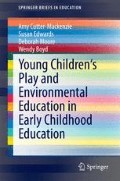Abstract
This chapter presents Robyn’s (an early childhood teacher) and the children’s experiences. Robyn’s kindergarten was located in an outer suburban part of Melbourne, Australia. Robyn focused on worms and making a wormery (a worm farm) owing to the children's interest in worms, and her goals were to provide children with greater understanding of worms and their habitats. Robyn’s play order was purposefully framed play, modelled play and open-ended play. Robyn brought in a large clod of soil rich in worms for the children to explore. She initiated purposefully framed play asking children in-depth questions about worms, used correct terminology and built a worm farm with the children. She used nonfiction books and scientific tools to enhance the children’s learning. During the modelled play children made their own worm farms under guidance from Robyn, and in the open-ended play they were given free rein to make their worm farm. This led to some of worms being drowned by the children using too much water, leading Robyn to step in to save the worms. Robyn identified that normally she would use all three strategies in the same play session rather than in isolation or separately. This articulation of the combined play types to environmental education is important for early childhood education as educators move in and out of teaching strategies depending on the children’s cues, their interests and the intent of teaching.
Access this chapter
Tax calculation will be finalised at checkout
Purchases are for personal use only
References
Epstein, A. S. (2007). The intentional teacher: Choosing the best strategies for young children’s learning. Washington, D.C.: National Association for the Education of Young Children.
Fleer, M. (2010). Early learning and development: Cultural-historical concepts in play. Melbourne: Cambridge University Press.
Littledyke, M., & McCrea, N. (2009). Starting sustainability early: Young children exploring people and places. In N. Taylor & C. Eames (Eds.), Education for sustainability in the primary curriculum: A guide for teachers (pp. 39–57). South Yarra, Vic.: Palgrave Macmillan.
Pearson, E., & Degotardi, S. (2009). Education for sustainable development in early childhood education: A global solution to local concerns? International Journal of Early Childhood, 41(2), 97–111.
Siraj-Blatchford, I. (2009). Conceptualising progression in the pedagogy of play and sustained shared thinking in early childhood education: A vygotskian perspective. Educational and Child Psychology, 26(2), 77–89.
Wood, E. (2013). Play, learning and the early childhood curriculum (3rd ed.). London: Sage Publications.
Author information
Authors and Affiliations
Corresponding author
Rights and permissions
Copyright information
© 2014 The Author(s)
About this chapter
Cite this chapter
Moore, D., Edwards, S., Cutter-Mackenzie, A., Boyd, W. (2014). Robyn: Worms Underground. In: Young Children's Play and Environmental Education in Early Childhood Education. SpringerBriefs in Education. Springer, Cham. https://doi.org/10.1007/978-3-319-03740-0_6
Download citation
DOI: https://doi.org/10.1007/978-3-319-03740-0_6
Published:
Publisher Name: Springer, Cham
Print ISBN: 978-3-319-03739-4
Online ISBN: 978-3-319-03740-0
eBook Packages: Humanities, Social Sciences and LawEducation (R0)

